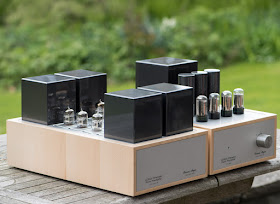In this post I am sharing photos of the finished EC8020 differential phono stage and some sound impressions.
This is how the signal section looks in it's chassis:
This time in a light wood color.
The chassis is extended by 60 mm compared to the usual size of my preamps to make enough room for all the iron inside.
The power supply in matching color scheme:
Signal section and power supply:
The power supply chassis was left in the standard length and is a bit shorter than the preamp.
Of course if wanted they could be made the same length.
The big question: is it worth to use twice as many of the precious EC8020 tubes and so much iron?
Quick answer: Yes, absolutely. The result is stunning.
The complete absence of capacitors in the signal path of the gain stages is revealing.
The improvements are similar as in the differential line stage over the single ended version. More pronounced small details like little changes of timbre or vibrato in voices makes the reproduction even more life like.
The sound is projected layer over layer into the room. Each instrument or voice can be easily followed in detail. Yet everything plays in an integrated harmonic fashion.
The playback is very relaxed and enjoyable without loss of detail or dynamics.
Sorry for the rant, but you wanted to get some information about the sound, right? All I can say I am very happy with the result and am curious which revelations the all silver version will bring.
Now some photos of the phono in operation, showing the tube glow.
8 Telefunken EC8020 glowing away is a sight to behold!
Besides an all silver version of this, I will also develop a differential phono based on the D3a tube.
Stay tuned!
Best regards
Thomas


























Totally ignorant question, but, in simple terms, what is the difference between differential and push-pull..?
ReplyDeleteHi!
Deletethere are different terms used symmetric, balanced, differential, push-pull. often no distinction is made between them although the mean slightly different things. Push-Pull is usually only used for power amps. technically you could call this phono push pull also. I use the term differential since that refers to how the signal is handled. For an in depth explanation best is to google these terms
best regards
Thomas
I love the light wood finish. The rest is not bad either. :-)
ReplyDeleteThe push pull is better sounding that single ended. Interesting. I have some D3a sitting around. Feel free to send me the D3a circuit diagram. :-)
Hi Thomas,
ReplyDeleteI was wondering if the differential approach you choose requires the tubes pair within each stage to be matched for mu and/or transconductance? I do not expect this information to reveal any secret about your design, however I would understand if you wouldn't want to disclose it.
Best regards,
Maxime
Hi!
DeleteYes the tubes should be matched quite well. Such high transconductance tubes should also be matched between channels in SE circuits. I use a curve tracer for perfectly matching plate curves